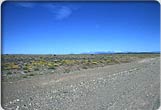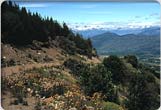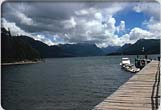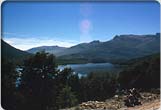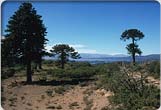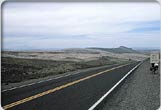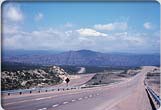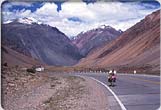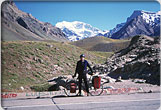| North to Mendoza |
| A few weeks later after riding North up the Carretera Austral I crossed again into Argentina, this time near Futaleufu and Esquel. I recall somewhere on this road finding an unbelievably well stocked store at an otherwise barren and exposed cross road. This is something I noticed a lot in Argentina. Other than passing traffic, where do these shops get their business from? Anywhere else I've ever cycled with population densities like this would have shops with the most pathetic choice of food. Another thing I noticed - cycle tourists, and lots of them. In Chile you could bet they were probably Europeans - Germans or Swiss usually. But here they were locals. Yes, Argentines love their cycle tours. The road seemed very rough. It was concrete hard dirt with bone jarring corrugations. My ten year old rear rack had fractured near Futaleufu (damn, knew I should have replaced it before I left!). Although my rough repair was holding I decided to head to Esquel and find a replacement rather than persevere as my map indicated a lot more dirt as I headed to the Argentine lakes district. The only alloy rack I could find was a bit flexy but I figured it'd do for now. The road through the Parque Nacional Los Aleces was lovely and recently graded. popular too. January school holidays were in full swing and the traffic was more than I'd seen in quite a while. I chugged North through some fairly mountainous roads. Many had been recently sealed and had wide shoulders. El Bolson claimed to be something of a counter-culture centre. Well maybe it was once but now it's an overdeveloped tourist trap/sports mecca sorta place. Best thing I could find about it was the ride up a nearby mountain (view from mountain looking southwest pictured) to watch Hang Gliders take off. Maybe out of season it's not quite so frenetic. |
| At San Martin de Los Andes I replaced the flexy rack with a Topeak branded one (it lasted only two months and was replaced in La Serena, Chile by a Blackburn Expedition rack I had sent mail order from Christie Cycles in Melbourne, Australia). I passed the older rack on to an Argentine cyclist who'd turned up at the campground carrying a huge backpack. From San Martin I headed through the lovely Parque Nacional Lanin and back into Chile. The crossing was easily the roughest road of my entire trip. It was also the hottest day. The heat and bumpiness conspired to soften the nylon rack clamps on my panniers enough for one of the panniers to jump off. It's the only time I've ever had an Ortlieb pannier part company with the bike. After revisiting Villarrica I headed off to the otherworldly Parque Nacional Conguillio Los Paraguas. If you've ever seen the TV series Walking With Dinosaurs, then you've seen this park. Much of it is grassless lava flows covered in Arucaria (a.k.a. Monkey Puzzle or Umbrella trees). Australians would recognise the Arucarias as ancient Gondwana relatives of the Bunya, Hoop and Wollemi Pines. Near Icalma I crossed back into Argentina again and back into a semi arid landscape. Pictured is Lago Alumine beyond some Arucarias. At the town of Zapala I discovered that local tourist bureau have very complete accommodation listings - and out of season they still seem to list high season prices. The town's campground seemed run down and filthy. I opted for the cheapest hotel and got a huge spotless room for half the tourist office price. Mosquitos too though, something else I'd have to get used to. Where the hell did they come from? Outside is almost a desert. |
| Between Chos Malal and Malargue was some great riding. A lot more of the road was paved than my map indicated. And there was no traffic. The wind had decided to aid me again. Tiny towns had more of those cyclist friendly shops with so much food to choose from and for a while the road ran through a great black lava flow. I could camp pretty much where I pleased. Malargue is a friendly biking town. Bikes were everywhere. After setting up at the municipal campground an old chap on a moped showed up asking for me. He'd seen me ride into town and decided to track me down and give me a tour. I pedalled along beside him as he putt putted about and gave me a history lecture about the town. We wound up at the town museum at about 9.00pm. Being Argentina it was of course still open and the museum director gave me a tour. It was excellent - on the walls were kitsch painting of local dignitaries. On one wall was a huge stuffed and mangy condor. One room was full of fossils, another had a Indian mummy and jars off all sorts of preserved stuff - including a two headed calf. This is just as municipal museums should be - full of unashamedly local colour. Cleaning my rear wheel at the campground next morning I discovered the rim had hairline cracks around every single hubside spoke hole. After Malargue came the wine region around San Rafael. A big town, but as bicycle centric as any town I've ever seen. Everywhere I looked were bikes. Many of them carried two people in all manner of permutations. Sometimes the passenger sat on the handlebars, sometimes on the crossbar or on the rear rack - facing forward, backward or sidesaddle. Some stood on the rack. Some sat on the rack and pedalled while the 'rider' steered. The campgrounds were too far from the centre so I opted for a hotel again. A Spanish cyclist, Manuel from Tarragona, was staying there and we ended up cycling together for a week. In Mendoza I looked unsuccessfully for a suitable rim but decided to bus into Santiago from Los Andes in Chile and have a look there once I'd crossed the Andes. |
| From Mendoza the road climbs relentlessly to Potrerillos, Uspallata and on to the Tunnel border crossing at Las Cuevas. The picture at right is taken fairly low down heading towards Potrerillos. At the time I was about 1000 metres above sea level. Above the cloud bank can be seen a mountain, possibly Aconcagua, the highest mountain in the Americas, in which case it would be over 6000m above me. Uspallata had been used as a base for filming Seven Years in Tibet. Many of the props wound up in a Tibetan themed bar and cars used a crew vehicles still proudly displayed their now sun faded "official" stickers. Beyond Uspallata the landscape is really quite epic. The wind howls and the mountains are bare and red (Pictured below). |
|
Home :: Santiago to Puerto Montt :: Isla Chiloe :: Carretera Austral :: Esquel to Mendoza :: Argentina to Antofagasta :: Around San Pedro :: San Pedro to Bolivia :: Bolivia :: Bolivia to Santiago
|
